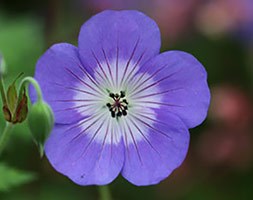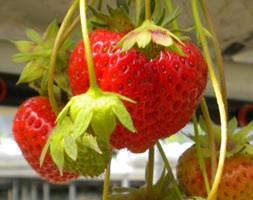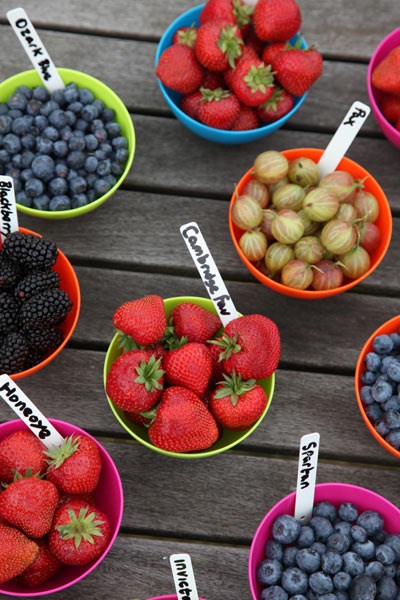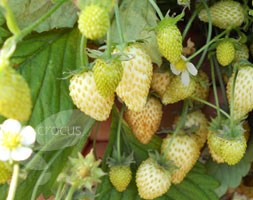Price reductions at Crocus
by Sarah - September 23rd, 2013.Filed under: Crocus, Price Reductions.
Reduced price on products today at Crocus
Geranium Rozanne (‘Gerwat’) (PBR) (cranesbill) was £9.99 now £8.99
Position: full sun or partial shade Soil: fertile, well-drained soil Rate of growth: fast-growing Flowering period: June to September Flower colour: violet-blue Hardiness: fully hardy Winner of the RHS Plant of the Centenary at Chelsea Flower Show 2013 Large (up to 5cm across), saucer-shaped, violet-blue flowers with white centres appear throughout the summer above the mounds of slightly-marbled, deep green foliage. Perfect for underplanting roses, or filling a few gaps in the front of a border, it copes well in full sun or partial shade. Garden care: In midsummer rejuvenate plants that are beginning to look jaded, by removing old flowered stems and leaves. Lift and divide large colonies in spring.
strawberry ‘Darselect’ (strawberry Darselect – early season fruiting) was £14.99 now £9.99
Position: full sun Soil: any soil Rate of growth: fast-growing Other features: ready to pick from June Hardiness: fully hardy Aromatic fruits with a deliciously sweet flavour appear early in the season on these vigorous, disease-resistant plants. Easy to pick and with a long shelf-life, ‘Darselect’ can be grown in pots and windowboxes as well as garden beds or under cover. Harvest them when their skin has turned brick-red for optimum flavour. Garden care: These strawberry runners are sent out as bare root (ie not potted up or in soil) plants. They are completely dormant, so any remaining foliage or stems will look shrivelled and dry. They should be planted out within a couple of days of arrival. Once they are planted out, they will emerge from their dormancy and start to put on new growth in spring (or within a 4 – 6 weeks if planted in spring). Choose a spot in full sun and prepare the bed well by removing all the weeds and digging in a generous amount of compost. You can also work in some general purpose fertiliser if planting in spring. When you are ready to plant, fill a bucket with tepid water and leave the plants to soak for 20 minutes. This will rehydrate the roots. While they are soaking, prepare the planting holes – these should be approximately twice as wide as the strawberries root system. Plant the strawberries so the crown (the point where the roots meet the stem) is at soil level, and spread the roots out before re-filling with soil. Space them at 45cm intervals, allowing 75cm between each row. After planting, immediately give them a thorough water and apply a generous layer of mulch around the base of the plants, being careful to avoid the crown. Keep the plants well watered, especially during warmer weather and when the fruits are developing. When the strawberries are starting to form, a thick layer of straw or a strawberry mulch mat can be placed under the plants to stop the fruit touching the soil. Sheets of black plastic mulch can also be used, and this will also help retain soil moisture, reduce weeds and encourage early cropping. Strawberries can also be planted in tubs, containers and hanging baskets.
strawberry ‘Cupid’ (strawberry Cupid – late season fruiting) was £14.99 now £9.99
Position: full sun Soil: any soil Rate of growth: fast-growing Other features: ready to pick from July Hardiness: fully hardy Glossy-skinned fruits appear amongst the vigorous growth of this extremely disease-resistant variety. A late cropper, it performs well on a wide range of soils and growing conditions, and it has a mouth-watering flavour. Garden care: These strawberry runners are sent out as bare root (ie not potted up or in soil) plants. They are completely dormant, so any remaining foliage or stems will look shrivelled and dry. They should be planted out within a couple of days of arrival. Once they are planted out, they will emerge from their dormancy and start to put on new growth in spring (or within a 4 – 6 weeks if planted in spring). Choose a spot in full sun and prepare the bed well by removing all the weeds and digging in a generous amount of compost. You can also work in some general purpose fertiliser if planting in spring. When you are ready to plant, fill a bucket with tepid water and leave the plants to soak for 20 minutes. This will rehydrate the roots. While they are soaking, prepare the planting holes – these should be approximately twice as wide as the strawberries root system. Plant the strawberries so the crown (the point where the roots meet the stem) is at soil level, and spread the roots out before re-filling with soil. Space them at 45cm intervals, allowing 75cm between each row. After planting, immediately give them a thorough water and apply a generous layer of mulch around the base of the plants, being careful to avoid the crown. Keep the plants well watered, especially during warmer weather and when the fruits are developing. When the strawberries are starting to form, a thick layer of straw or a strawberry mulch mat can be placed under the plants to stop the fruit touching the soil. Sheets of black plastic mulch can also be used, and this will also help retain soil moisture, reduce weeds and encourage early cropping. Strawberries can also be planted in tubs, containers and hanging baskets.
strawberry ‘Fenella’ (PBR) (strawberry – mid to late season fruiting) was £14.99 now £9.99
Position: full sun Soil: any soil Rate of growth: fast-growing Other features: tasty, red fruit (mid-July) Cropping times may be brought forward or extended if you are growing them in a greenhouse or cloche tunnel. Hardiness: fully hardy Standing up well to adverse weather conditions, this vigorous plant bears a heavy crop of fruit late in the season. The large, aromatic berries are very sweet and juicy, have a glossy, orange-red skin, and store well after being picked from mid-July. Garden care: These strawberry runners are sent out as bare root (ie not potted up or in soil) plants. They are completely dormant, so any remaining foliage or stems will look shrivelled and dry. They should be planted out within a couple of days of arrival. Once they are planted out, they will emerge from their dormancy and start to put on new growth in spring (or within a 4 – 6 weeks if planted in spring). Choose a spot in full sun and prepare the bed well by removing all the weeds and digging in a generous amount of compost. You can also work in some general purpose fertiliser if planting in spring. When you are ready to plant, fill a bucket with tepid water and leave the plants to soak for 20 minutes. This will rehydrate the roots. While they are soaking, prepare the planting holes – these should be approximately twice as wide as the strawberries root system. Plant the strawberries so the crown (the point where the roots meet the stem) is at soil level, and spread the roots out before re-filling with soil. Space them at 45cm intervals, allowing 75cm between each row. After planting, immediately give them a thorough water and apply a generous layer of mulch around the base of the plants, being careful to avoid the crown. Keep the plants well watered, especially during warmer weather and when the fruits are developing. When the strawberries are starting to form, a thick layer of straw or a strawberry mulch mat can be placed under the plants to stop the fruit touching the soil. Sheets of black plastic mulch can also be used, and this will also help retain soil moisture, reduce weeds and encourage early cropping. Strawberries can also be planted in tubs, containers and hanging baskets.
strawberry ‘Cambridge Favourite’ (strawberry – mid season fruiting) was £14.99 now £9.99
Position: full sun Soil: any soil Rate of growth: fast-growing Other features: tasty, orange-red fruit (mid-June to mid-July) Cropping times may be brought forward or extended if you are growing them in a greenhouse or cloche tunnel. Hardiness: fully hardy This is one of the most well-known and loved strawberry varieties available. It is a reliable cropper, has good all-round disease resistance and performs well on a wide range of soils and growing conditions. It produces medium-sized, orange-red fruit from mid-June, which hold their shape and flavour very well. Garden care: These strawberry runners are sent out as bare root (ie not potted up or in soil) plants. They are completely dormant, so any remaining foliage or stems will look shrivelled and dry. They should be planted out within a couple of days of arrival. Once they are planted out, they will emerge from their dormancy and start to put on new growth in spring (or within 4 – 6 weeks if planted in spring). Choose a spot in full sun and prepare the bed well by removing all the weeds and digging in a generous amount of compost. You can also work in some general purpose fertiliser if planting in spring. When you are ready to plant, fill a bucket with tepid water and leave the plants to soak for 20 minutes. This will rehydrate the roots. While they are soaking, prepare the planting holes – these should be approximately twice as wide as the strawberries root system. Plant the strawberries so the crown (the point where the roots meet the stem) is at soil level, and spread the roots out before re-filling with soil. Space them at 45cm intervals, allowing 75cm between each row. After planting, immediately give them a thorough water and apply a generous layer of mulch around the base of the plants, being careful to avoid the crown. Keep the plants well watered, especially during warmer weather and when the fruits are developing. When the strawberries are starting to form, a thick layer of straw or a strawberry mulch mat can be placed under the plants to stop the fruit touching the soil. Sheets of black plastic mulch can also be used, and this will also help retain soil moisture, reduce weeds and encourage early cropping. Strawberries can also be planted in tubs, containers and hanging baskets.
strawberry ‘Albion’ (PBR) (everbearer strawberry – autumn season fruiting) was £14.99 now £9.99
Position: full sun Soil: any soil Rate of growth: fast-growing Other features: tasty, red fruit (July to November) Cropping times may be brought forward or extended if you are growing them in a greenhouse or cloche tunnel. Hardiness: fully hardy An ever-bearing strawberry that can start cropping as early as late May, and continue producing its fruits intermittently until September. Each sweet, succulent berry has a long, conical shape, bright red skin and uniformly red flesh. It has an excellent resistance to disease too. Garden care: These strawberry runners are sent out as bare root (ie not potted up or in soil) plants. They are completely dormant, so any remaining foliage or stems will look shrivelled and dry. They should be planted out within a couple of days of arrival. Once they are planted out, they will emerge from their dormancy and start to put on new growth in spring (or within a 4 – 6 weeks if planted in spring). Choose a spot in full sun and prepare the bed well by removing all the weeds and digging in a generous amount of compost. You can also work in some general purpose fertiliser if planting in spring. When you are ready to plant, fill a bucket with tepid water and leave the plants to soak for 20 minutes. This will rehydrate the roots. While they are soaking, prepare the planting holes – these should be approximately twice as wide as the strawberries root system. Plant the strawberries so the crown (the point where the roots meet the stem) is at soil level, and spread the roots out before re-filling with soil. Space them at 45cm intervals, allowing 75cm between each row. After planting, immediately give them a thorough water and apply a generous layer of mulch around the base of the plants, being careful to avoid the crown. Keep the plants well watered, especially during warmer weather and when the fruits are developing. When the strawberries are starting to form, a thick layer of straw or a strawberry mulch mat can be placed under the plants to stop the fruit touching the soil. Sheets of black plastic mulch can also be used, and this will also help retain soil moisture, reduce weeds and encourage early cropping. Strawberries can also be planted in tubs, containers and hanging baskets.
Strawberry ‘Delia’ (strawberry – early – mid season fruiting) was £14.99 now £9.99
Position: full sun Soil: any soil Rate of growth: fast-growing Other features: ready to pick from July Hardiness: fully hardy Larger than average, conical fruits, with a glossy orange-red skin and firm, juicy flesh, can be harvested from amongst the dark green foliage of this early-fruiting strawberry. An easy to harvest cultivar, the fruits last well on the plants and are also good for storing. Garden care: These strawberry runners are sent out as bare root (ie not potted up or in soil) plants. They are completely dormant, so any remaining foliage or stems will look shrivelled and dry. They should be planted out within a couple of days of arrival. Once they are planted out, they will emerge from their dormancy and start to put on new growth in spring (or within a 4 – 6 weeks if planted in spring). Choose a spot in full sun and prepare the bed well by removing all the weeds and digging in a generous amount of compost. You can also work in some general purpose fertiliser if planting in spring. When you are ready to plant, fill a bucket with tepid water and leave the plants to soak for 20 minutes. This will rehydrate the roots. While they are soaking, prepare the planting holes – these should be approximately twice as wide as the strawberries root system. Plant the strawberries so the crown (the point where the roots meet the stem) is at soil level, and spread the roots out before re-filling with soil. Space them at 45cm intervals, allowing 75cm between each row. After planting, immediately give them a thorough water and apply a generous layer of mulch around the base of the plants, being careful to avoid the crown. Keep the plants well watered, especially during warmer weather and when the fruits are developing. When the strawberries are starting to form, a thick layer of straw or a strawberry mulch mat can be placed under the plants to stop the fruit touching the soil. Sheets of black plastic mulch can also be used, and this will also help retain soil moisture, reduce weeds and encourage early cropping. Strawberries can also be planted in tubs, containers and hanging baskets.
strawberry ‘Lucy’ (strawberry Lucy – late season fruiting) was £14.99 now £9.99
Position: full sun Soil: any soil Rate of growth: fast-growing Other features: ready to pick from mid June Hardiness: fully hardy Producing a high yield of top-class large fruits, which have firm, juicy flesh and a bright red skin, this vigorous strawberry also shows a good resistance to diseases. It copes well with heavy rain, making it particularly well suited to growing here in the UK. Garden care: These strawberry runners are sent out as bare root (ie not potted up or in soil) plants. They are completely dormant, so any remaining foliage or stems will look shrivelled and dry. They should be planted out within a couple of days of arrival. Once they are planted out, they will emerge from their dormancy and start to put on new growth in spring (or within a 4 – 6 weeks if planted in spring). Choose a spot in full sun and prepare the bed well by removing all the weeds and digging in a generous amount of compost. You can also work in some general purpose fertiliser if planting in spring. When you are ready to plant, fill a bucket with tepid water and leave the plants to soak for 20 minutes. This will rehydrate the roots. While they are soaking, prepare the planting holes – these should be approximately twice as wide as the strawberries root system. Plant the strawberries so the crown (the point where the roots meet the stem) is at soil level, and spread the roots out before re-filling with soil. Space them at 45cm intervals, allowing 75cm between each row. After planting, immediately give them a thorough water and apply a generous layer of mulch around the base of the plants, being careful to avoid the crown. Keep the plants well watered, especially during warmer weather and when the fruits are developing. When the strawberries are starting to form, a thick layer of straw or a strawberry mulch mat can be placed under the plants to stop the fruit touching the soil. Sheets of black plastic mulch can also be used, and this will also help retain soil moisture, reduce weeds and encourage early cropping. Strawberries can also be planted in tubs, containers and hanging baskets.
strawberry ‘Leo Alba’ (alpine strawberry) was £14.99 now £9.99
Position: full sun to light shade Soil: any soil Rate of growth: fast-growing Other features: ready to pick June / July Hardiness: fully hardy The unusual fruits of this alpine strawberry never ripen to red, but you will know they are ripe and ready to pick when they feel soft to the touch. Their flavour is unexpectedly refreshing too, sweet and delicate, with undertones of vanilla and pineapple. Smaller than the commercially grown strawberries, these have the advantage though of being able to crop over a much longer period in ideal conditions. Garden care: These strawberry runners are sent out as bare root (ie not potted up or in soil) plants. They are completely dormant, so any remaining foliage or stems will look shrivelled and dry. They should be planted out within a couple of days of arrival. Once they are planted out, they will emerge from their dormancy and start to put on new growth in spring (or within a 4 – 6 weeks if planted in spring). Choose a spot in full sun and prepare the bed well by removing all the weeds and digging in a generous amount of compost. You can also work in some general purpose fertiliser if planting in spring. When you are ready to plant, fill a bucket with tepid water and leave the plants to soak for 20 minutes. This will rehydrate the roots. While they are soaking, prepare the planting holes – these should be approximately twice as wide as the strawberries root system. Plant the strawberries so the crown (the point where the roots meet the stem) is at soil level, and spread the roots out before re-filling with soil. Space them at 45cm intervals, allowing 75cm between each row. After planting, immediately give them a thorough water and apply a generous layer of mulch around the base of the plants, being careful to avoid the crown. Keep the plants well watered, especially during warmer weather and when the fruits are developing. When the strawberries are starting to form, a thick layer of straw or a strawberry mulch mat can be placed under the plants to stop the fruit touching the soil. Sheets of black plastic mulch can also be used, and this will also help retain soil moisture, reduce weeds and encourage early cropping. Strawberries can also be planted in tubs, containers and hanging baskets.















